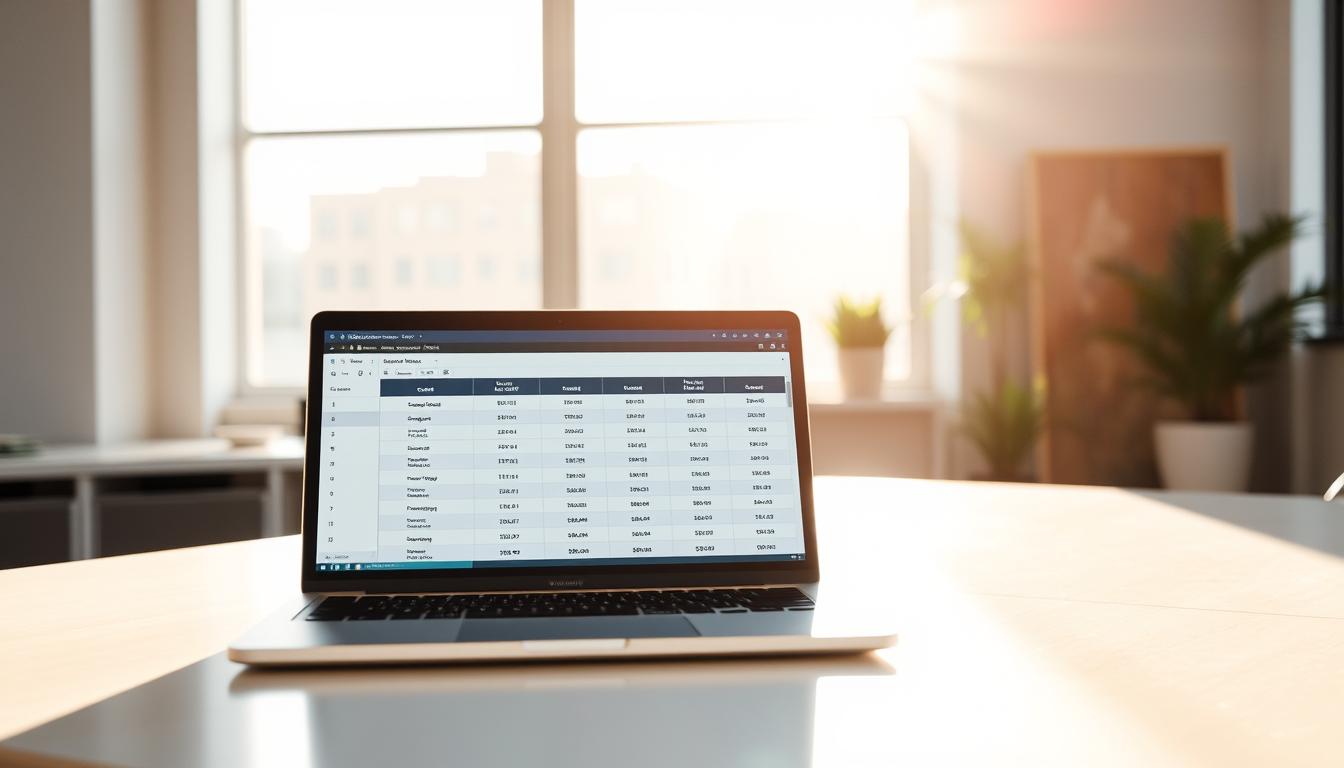Are you having trouble extracting data from Perplexity AI in a way you can use? You’re not alone. Many people struggle to copy tables from the platform. This guide will help you through the process, making it easier to work with the data you need.
Perplexity AI is a powerful tool, but it can be hard to extract data from it. This guide will show you how to copy tables efficiently. This will boost your productivity and workflow.
Key Takeaways
- Understand the limitations of Perplexity AI’s data extraction capabilities.
- Learn step-by-step methods to copy tables from Perplexity AI.
- Discover tips to enhance your productivity when working with extracted data.
- Explore alternative methods for data extraction if needed.
- Improve your overall workflow by efficiently handling data from Perplexity AI.
Understanding Perplexity AI and Its Table Functionality
Exploring Perplexity AI reveals its ability to create tables from complex data. It makes data easier to understand and use. This tool is great for simplifying data analysis.
What is Perplexity AI?
Perplexity AI is a tool that uses artificial intelligence. It collects, analyzes, and presents data. It aims to give users the right information they need.
How Tables Are Generated in Perplexity AI
Tables in Perplexity AI are made based on what the user asks. The AI looks at the query, finds the right data, and puts it into a table. This makes data easy to see and use.
Types of Data Presented in Tables
Tables in Perplexity AI show different kinds of data. This includes comparisons, statistics, and summaries. For example, you might see tables that compare products or summarize financial data.
| Data Type | Description | Example Use Case |
|---|---|---|
| Comparative Data | Compares different entities or features | Product comparison charts |
| Statistical Information | Presents statistical data or trends | Market trend analysis |
| Data Summaries | Summarizes large datasets into key insights | Financial summary reports |

Why You Might Need to Copy Tables from Perplexity AI
Getting data from Perplexity AI’s tables can really help with your research, analysis, and content creation. The tables are full of useful information. They are great for many uses.
Research and Academic Purposes
Researchers and academics can save time by copying tables from Perplexity AI. It makes it easy to add important data to your work. You can use it to back up your ideas, compare things, or show complex info simply.

Business Data Analysis
Business folks can copy tables from Perplexity AI to analyze market trends and consumer behavior. This data helps with making plans, predicting the future, or finding new chances.
Content Creation and Reporting
Content makers and reporters can also use Perplexity AI’s tables. They add accurate and current data to your articles, reports, or other content. This makes your work more believable and interesting to your readers.
Preparing Your Environment for Table Copying
Getting your digital workspace ready is the first step to copy tables from Perplexity AI. You need to think about a few important things for a smooth process.
Browser Compatibility Considerations
Your browser is key to using Perplexity AI. It’s important to make sure your browser works well with the platform.
Recommended Browsers
For the best experience, use modern browsers. Google Chrome, Mozilla Firefox, or Microsoft Edge are good choices. They work well with complex web apps.
Browser Settings to Adjust
Check your browser settings to let Perplexity AI work right. You might need to turn on JavaScript and allow pop-ups from the site.
Required Permissions and Access
You might need to change your browser’s permissions for Perplexity AI. Check your browser’s settings to make sure you have all the needed permissions.
How to Copy Table from Perplexity AI: Basic Method
Copying tables from Perplexity AI is easy and takes just four steps. It’s perfect for those who need to move data fast and efficiently.
Step1: Generating the Table with Your Query
To start, use Perplexity AI’s query function to create a table. Type your search query or request in the field. Perplexity AI will then make a table for you. Make sure your query is clear to get the right data.
Step2: Selecting the Entire Table
After the table is made, select it all to copy it. There are two main ways to do this:
Mouse Selection Techniques
Click and drag from the top-left to the bottom-right corner of the table with your mouse. This will highlight the whole table, showing it’s selected.
Keyboard Shortcuts
Or, use keyboard shortcuts to select the table. Press Ctrl + A (or Cmd + A on a Mac) to select everything. This is often faster and more accurate than the mouse.
Step3: Executing the Copy Command
Now that the table is selected, you can copy it. Right-click on the table and choose Copy from the menu, or press Ctrl + C (or Cmd + C on a Mac).
Step4: Pasting to Your Destination Application
Open your destination app, like a spreadsheet or word processor. Put your cursor where you want the table. Then, right-click and pick Paste or press Ctrl + V (or Cmd + V on a Mac).
Advanced Copy Methods for Different Destinations
To copy tables from Perplexity AI, knowing your target application’s needs is key. Each software has its own features that impact how you copy tables.
Copying to Spreadsheet Applications
When copying to spreadsheets, specific features can help a lot. These features make handling data easier.
Microsoft Excel-Specific Techniques
In Microsoft Excel, the “Paste Special” feature is very useful. It lets you choose how to paste data, like values only or formatting. This is great for dealing with big data sets.
Google Sheets Optimization
Google Sheets lets you paste data straight into cells. You can also use IMPORTHTML to bring in tables from websites.
Copying to Word Processors
Word processors like Microsoft Word and Google Docs handle pasted tables differently.
Microsoft Word
In Microsoft Word, you can paste tables directly. The “Paste Options” let you keep the original look or change it to match your document.
Google Docs
Google Docs also supports pasting tables. You can adjust column widths and formatting to fit your document.
Copying to Database Applications
When copying data to databases, making sure the format fits your database is critical.
Comparison of Copying Methods
| Application | Copy Method | Formatting Options |
|---|---|---|
| Microsoft Excel | Paste Special | Values, Formatting |
| Google Sheets | Direct Paste or IMPORTHTML | Dynamic Import |
| Microsoft Word | Paste Options | Maintain Formatting |
| Google Docs | Direct Paste | Adjust Column Widths |
Using Browser Extensions for Enhanced Table Copying
Boost your data extraction skills with browser extensions made for table capture and data scraping. These tools make copying tables from Perplexity AI easier and more accurate.
Table Capture Extensions
Table capture extensions make it simple to get data from web pages. They find tables automatically and let you copy them with one click.
Installation and Setup
To start, install the extension from your browser’s store. Most are simple to install and need little setup.
Usage Instructions
After installing, click the extension’s icon in your toolbar to use it. Then, pick the table you want to capture and follow the prompts to copy the data.
Data Scraping Extensions
Data scraping extensions have more features. They let you pull specific data from web pages, including complex tables.
Clipboard Enhancement Tools
Clipboard tools improve your workflow. They offer advanced paste options and data formatting.
Using these browser extensions can greatly boost your productivity with tables from Perplexity AI. Whether it’s simple tables or complex data, there’s an extension for you.
Preserving Table Formatting During the Copy Process
Keeping table formatting when copying is key for data integrity and looks. When copying tables from Perplexity AI, the original look can get lost. This makes the data look less professional and can lead to wrong interpretations.
Understanding Format Loss Issues
Format loss happens when the table’s look and feel are not kept during copying. This is due to how different apps handle table data.
HTML Formatting Preservation Techniques
Using HTML to copy tables is a great way to keep their original look. This method helps keep the table’s structure and style intact.
Using Paste Special Options
Many apps have “Paste Special” options. These let you pick how the table is pasted. This is super helpful for keeping the formatting.
Text-Only Options
Text-only paste options remove all formatting. They give you a plain text version of the table. This is good if you want to get rid of all styling.
Formatted Text Options
Formatted text paste options, on the other hand, keep the original formatting. They help keep the table’s look and feel.
By using these methods, you can keep table formatting when copying from Perplexity AI. This makes sure your data stays accurate and looks good.
Troubleshooting Common Table Copying Issues
If you’re having trouble copying tables from Perplexity AI, you’re not alone. Let’s look at some fixes. Copying tables can be tricky due to table selection problems, formatting issues, and character encoding issues.
Table Selection Problems
One common issue is not selecting the whole table. This can lead to copying only part of the data.
Partial Selection Issues
To fix this, try selecting the table again. Or use Ctrl+A (or Command+A on Mac) to select everything.
Interactive Table Challenges
Interactive tables, like those with changing content, can be tricky. Try pausing or stopping any interactive parts before copying.
Formatting Distortion After Pasting
When pasting tables into other apps, formatting issues can happen. To avoid this, use “Paste Special” and choose “Unformatted Text” or “Keep Source Formatting.”
Character Encoding Problems
Character encoding issues can cause text to appear jumbled. Make sure the encoding settings match between the source and destination apps.
Browser-Specific Issues and Solutions
Different browsers handle table copying in unique ways. Try using a different browser or update your current one to the latest version.
| Browser | Table Copying Behavior | Solution |
|---|---|---|
| Google Chrome | May have issues with interactive tables | Update to the latest version |
| Mozilla Firefox | Generally handles table copying well | Check for extensions interfering with copying |
| Microsoft Edge | May have issues with table formatting | Try using “Paste Special” |
Converting Copied Tables to Different Formats
To get the most from data copied from Perplexity AI, changing its format is key. This makes the data work better for different uses. It also makes it easier to use.
Converting to CSV Format
CSV (Comma Separated Values) is a common format for sharing data. To turn your table into CSV, you can do it manually or use online tools.
Manual Conversion Steps
- Open your spreadsheet app (like Microsoft Excel or Google Sheets).
- Paste the table into a new sheet.
- Save it as CSV using the “Save As” option.
Using Online Converters
You can also use online tools to convert tables to CSV. These tools work with HTML and plain text too.
Converting to JSON Format
JSON (JavaScript Object Notation) is great for web and mobile apps. You can change your table to JSON with programming libraries or online tools.
Converting to PDF and Other Document Formats
To present data formally, convert it to PDF or other formats. Use your spreadsheet or word processor’s “Print” or “Export” options. Choose PDF as the format.
Data Transformation Tools
For complex data changes, use specialized tools. They help reshape, filter, and group your data. This makes it easier to get the format you need.
Tips for Working with Large Complex Tables
To work well with big tables from Perplexity AI, you need smart strategies. These help overcome performance limits. It’s key to make your workflow efficient to stay productive.
Handling Memory and Performance Limitations
Big tables can use up a lot of your computer’s memory and slow it down. To fix this, close apps and background tasks you don’t need. Also, save your work often to avoid losing data if your system crashes.
Breaking Down Large Tables into Manageable Chunks
Splitting big tables into smaller parts is a smart move. You can divide the data into different sheets or files. Use criteria like date ranges or categories to do this.
Batch Processing Techniques
Batch processing means working with data in parts, not all at once. It’s great for big tables. For example, you can apply formulas or clean data in stages.
Data Validation After Copying
After copying a big table, check the data for accuracy and integrity. Look for formatting problems, missing values, or data errors. Using data validation rules helps spot issues and keeps data quality high.
| Technique | Description | Benefit |
|---|---|---|
| Breaking Down Tables | Splitting large tables into smaller ones | Easier to manage and analyze |
| Batch Processing | Handling data in batches | Reduces memory strain and improves performance |
| Data Validation | Checking data for accuracy and integrity | Ensures data quality and reliability |
Automating Table Extraction from Perplexity AI
Automating table extraction from Perplexity AI can boost your productivity. It saves time and cuts down on manual effort in data collection and analysis.
Using Browser Automation Scripts
Browser automation scripts are a strong tool for extracting tables from Perplexity AI. They can act like a user, navigating and getting the data you need.
Python Solutions with Selenium
Selenium is great for automating browsers, and it works well with Python. You can write scripts to go to Perplexity AI, search, and pull out tables easily.
JavaScript Automation Options
If you know JavaScript, Puppeteer is a powerful choice for automating browsers. It helps automate table extraction, fitting various needs.
API Integration Possibilities
API integration is a direct way to automate table extraction. It lets you use Perplexity AI’s API to get data automatically, making your workflow smoother.
Scheduled Extraction Workflows
Setting up scheduled workflows for table extraction takes it further. Tools like cron jobs or scheduling libraries keep your data current.
Integration with Data Processing Tools
The data you extract can be easily added to data processing tools for analysis. This integration helps you get insights, improving your decision-making.
Conclusion
You now know how to copy tables from Perplexity AI. This makes working with data easier. You can get the info you need by following a few steps.
Getting ready, choosing the right method, and solving problems are key. You can copy tables using simple or advanced methods. This prepares you for different data tasks.
Learning to copy tables from Perplexity AI helps a lot. It makes your work flow better, whether you’re researching, analyzing, or creating content. By using the tips and methods we discussed, you can improve how you handle data.
In short, copying tables from Perplexity AI helps you work smarter with data. It boosts your productivity and helps you make better decisions. As you keep using Perplexity AI, these skills will become even more important for your work.


